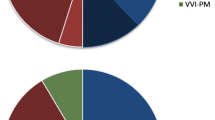Abstract
The optimal pacing mode for patients with paroxysmal atrial fibrillation (AF) following AV junction ablation remains the subject of some debate. Recent clinical trials have not demonstrated a superior advantage of maintenance of sinus rhythm over the rate control approach. However, clinical trials in pacemaker populations have demonstrated that physiologic pacing reduces the probability of paroxysmal and persistent AF compared to ventricular pacing. In the second phase of the PA3 study, patients were randomized to DDDR versus VDD pacing in a cross over study design. Of the 67 patients randomized, 42% developed permanent AF within one year following ablation. AF frequency and burden increases early following AV junction ablation suggesting that ventricular pacing even in an atrial synchronous mode promotes AF. Given the high probability of permanent AF developing early following ablation, VVIR pacing appears to be the appropriate pacing mode for symptomatic patients undergoing total AV junction ablation.
Similar content being viewed by others
References
Wood MA, Brown-Mahoney C, Kay GN, Ellenbogen KA. Clinical outcomes after ablation and pacing therapy for atrial fibrillation: A meta-analysis. Circulation 2000;101:1138–1144.
Gillis AM, Connolly SJ, Lacombe P, Philippon F, Dubuc M, Kerr CR, Yee R, Rose MS, Newman D, Kavanagh KM, Gardner MJ, Wyse DG for the PA3 Investigators. A randomized crossover comparison of DDDR versus VDD pacing post-AV node ablation for prevention of atrial fibrillation. Circulation 2000;102:736–741.
Brignole M, Gianfranchi L, Menozzi C, Alboni P, Musso G, Bongiorni MG, Gasparini M, Raviele A, Lolli G, Paparella N, Acquarone S. Assessment of atrio-ventricular junction ablation and DDDR mode-switching pacemaker versus pharmacological treatment in patients with severely symptomatic paroxysmal atrial fibrillation: A randomized controlled study. Circulation 1997;96:2613–2624.
Gribbin GM, Bourke JP, McComb JM. Predictors of atrial rhythm after atrioventricular node ablation for the treatment of paroxysmal atrial arrhythmias. Heart 1998;79:548–553.
Gianfranchi L, Brignole M, Menozzi C, Lolli G, Bottoni N. Progression of permanent atrial fibrillation after atrioventricular junction ablation and dual chamber pacemaker implantation in patients with paroxysmal atrial tachyarrhythmias. Am J Cardiol 1998;81:351–354.
Wyse DG, Waldo AL, DiMarco JP, Domanski MJ, Rosenberg Y, Schron EB, Kellen JC, Greene HL, Mickel MC, Dalquist JE, Corley SD. A comparison of rate control and rhythm control in patients with atrial fibrillation. N Engl J Med 2002;5(347):1825–1833.
Van Gelder IC, Hagens VE, Bosker HA, Kingma JH, Kamp O, Kingma T, Said SA, Darmanata JI, Timmermans AJ, Tijssen JG, Crijns HJ. A comparison of rate control and rhythm control in patients with recurrent persistent atrial fibrillation. N Engl J Med 2002;347:1834–1840.
Connolly SJ,Kerr CR,Gent M,Roberts RS, Yusef S,Gillis AM,Sami MH,Talajic M,Tang AS,Klein GJ, Lau C,Newman DM for the CTOPP Investigators. Effects of physiologic pacing versus ventricular pacing on the risk of stroke and death due to cardiovascular causes. N Engl J Med 2000;342:1385–1391.
Lamas GA, Lee KL, Sweeney MO, Silverman R, Leon A, Yee R, Marinchak RA, Flaker G, Schron E, Orav EJ, Hellkamp AS, Greer S, McAnulty J, Ellenbogen K, Ehlert F, Freedman RA, Estes NA 3rd, Greenspon A, Goldman L. Ventricular pacing or dual-chamber pacing for sinus-node dysfunction. N Engl J Med 2002;346:1854–1862.
Tang AS, Roberts RS, Kerr C, Gillis AM, Green MS, Talajic M, Yusuf S, Abdollah H, Gent M, Connolly SJ. Relationship between pacemaker dependency and the effect of pacing mode on cardiovascular outcomes. Circulation 2001;103:3081–3085.
Gillis AM, Wyse DG, Connolly SJ, Dubuc M, Philippon F, Yee R, Lacombe P, Rose MS, Kerr CR for the Atrial Pacing Periablation for Paroxysmal Atrial Fibrillation (PA3) Study Investigators. Atrial pacing peri-ablation for prevention of paroxysmal atrial fibrillation. Circulation 1999;99:2553–2558.
Sweeney MO, Hellkamp AS, Ellenbogen KA, Greenspon AJ, Freedman RA, Lee KL, Lamas GA, Mode Selection Trial Investigators. Adverse effect of ventricular pacing on heart failure and atrial fibrillation among patients with normal baseline QRS duration in a clinical trial of pacemaker therapy for sinus node dysfunction. Circulation 2003;107:2932–2937.
Willems R, Wyse DG, Gillis AM. Total AV nodal (TAVN) ablation worsens atrial fibrillation (AF) burden in patients with paroxysmal AF. Circulation 2002;19:II–406.
Author information
Authors and Affiliations
Rights and permissions
About this article
Cite this article
Gillis, A.M. Selection of Pacing Mode after Interruption of Atrioventricular Conduction for Atrial Fibrillation: Observations from the PA3 Clinical Trial. Card Electrophysiol Rev 7, 312–314 (2003). https://doi.org/10.1023/B:CEPR.0000023130.12304.e4
Issue Date:
DOI: https://doi.org/10.1023/B:CEPR.0000023130.12304.e4




